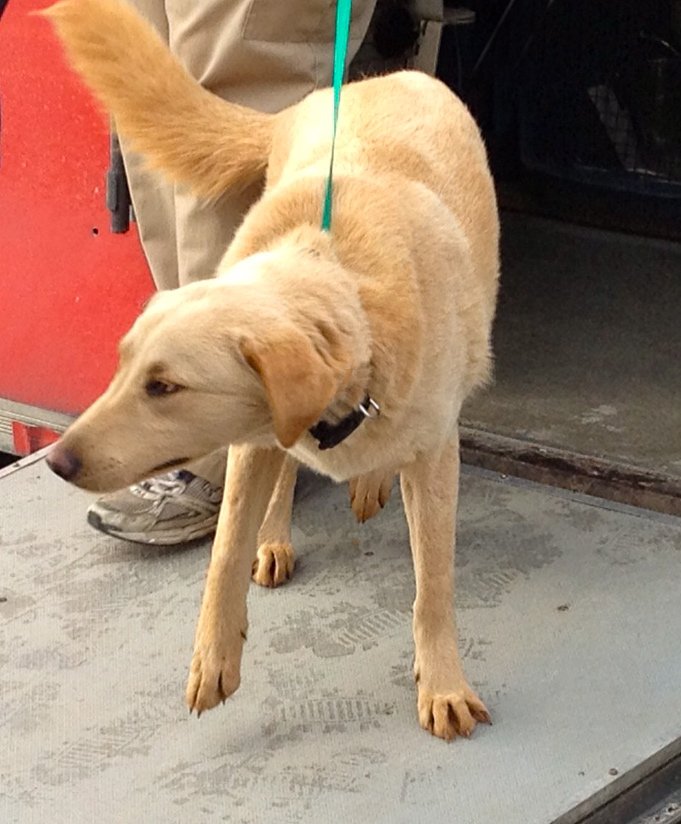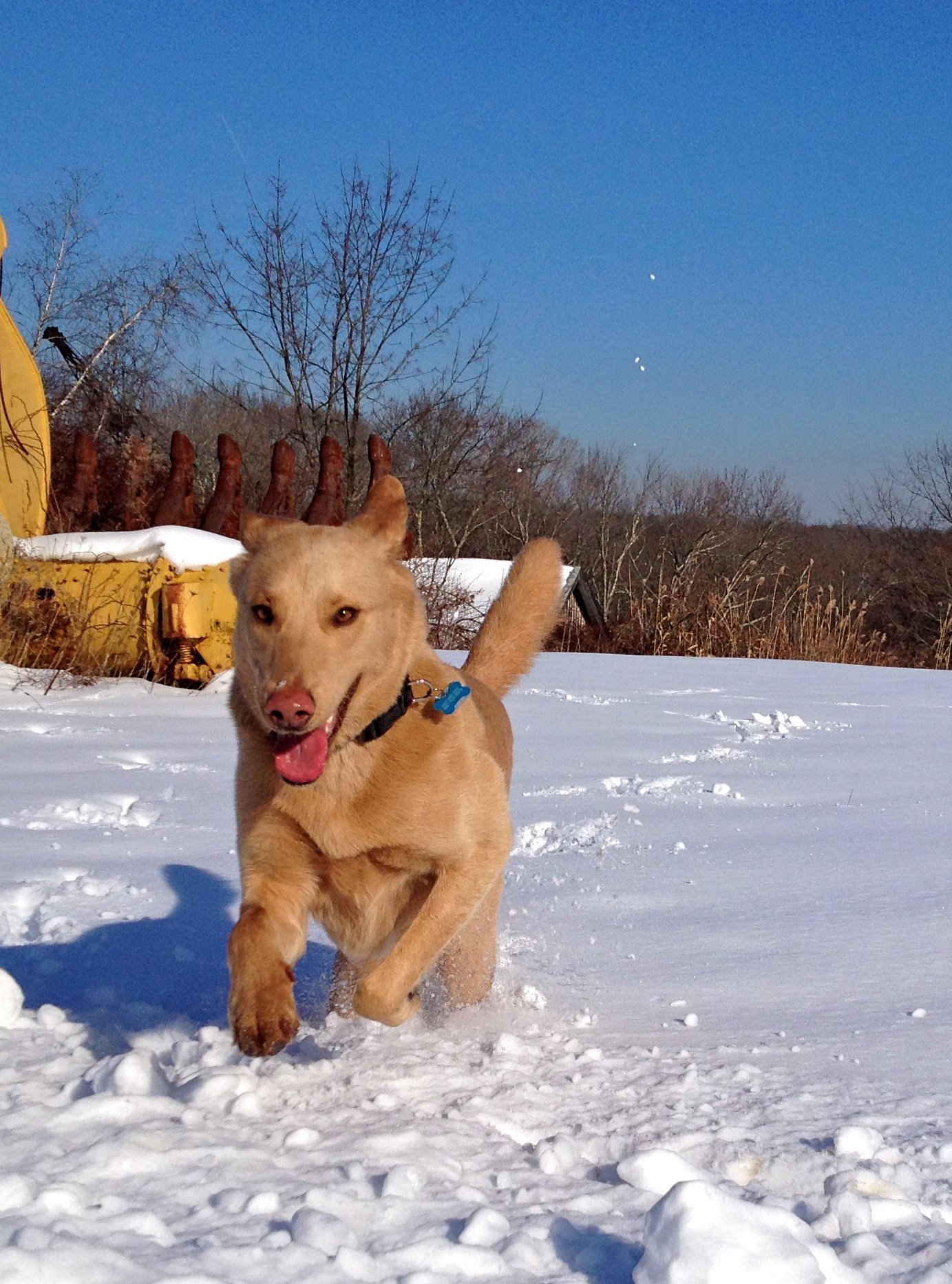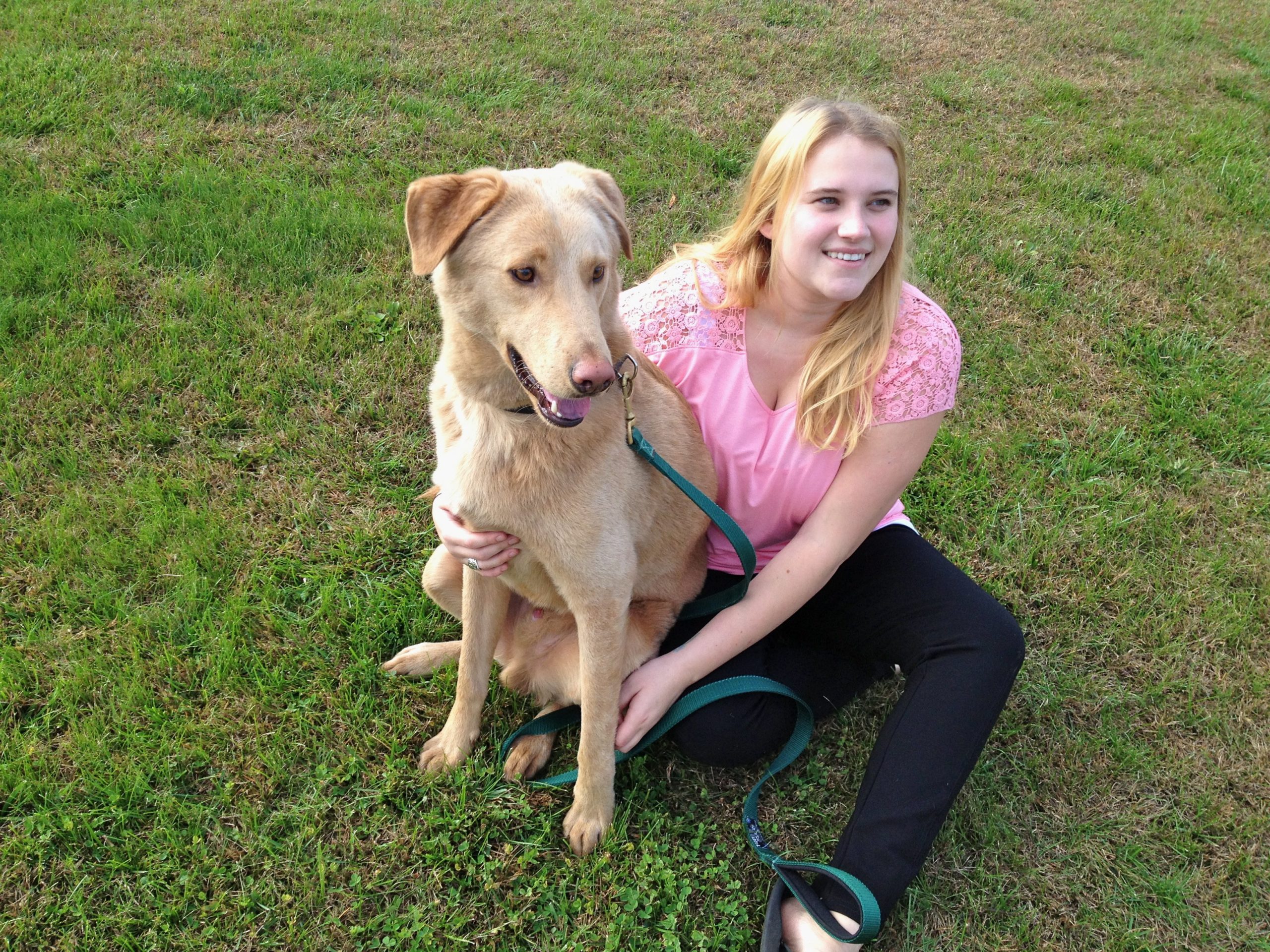“I found Huckster online,” says Leigh Becker of Willington, Connecticut. “He was a Lab/shepherd mix from a shelter in Mississippi. He came from one of the organizations that works nationwide to place dogs in homes.
“When he came off the transport truck, I was really excited. But he was just hobbling. He was absolutely crippled. We were devastated, but I thought maybe it was just a minor injury that would heal on its own.
“After a couple of days with no improvement, we took him to Tufts. They took x-rays, and it was pretty apparent” what was wrong.

Diagnosis of hip dysplasia
It turned out 10-month-old Huck, still a puppy, had severe hip dysplasia. It’s a condition inherited from one or both of a dog’s parents, and it means the animal has a joint disorder in which the two bones that form the hip joint don’t fit together properly. They are the thighbone, or femur, and the pelvis. Some dogs have dysplasia that doesn’t cause too much discomfort. In those cases, the problem can often be treated with medication and lifestyle management, including dietary and exercise modifications. That wasn’t the case with Huck. “He was so bad off,” says Ms. Becker, “that his hip joint in both legs was dislocated. We had to do something that was going to totally change mechanically how he was built.”
Hip dysplasia is a developmental problem — meaning the disease develops as the dog grows — and is an all-too-common one, tending to occur in certain breeds. “Retrievers are commonly affected, both Labradors and goldens, as are German shepherds,” says Michael Kowaleski, DVM, an associate professor of small animal orthopedic surgery at Tufts. That is, it’s no surprise that Huckster, part Lab and part shepherd, was afflicted. “Newfoundlands are another commonly affected breed,” Dr. Kowaleski says, “and Bernese mountain dogs.” But a dog of any breed and any size may develop hip dysplasia that begins to evidence itself by the time the animal is just several months old. Typical signs include limping or a “bunny-hopping gait,” comments Dr. Kowaleski, meaning “running with both hind legs like a rabbit rather than one leg at a time. The dog may also not want to play,” which, of course, is especially unusual for a young pet.
Enter hip replacement
The best solution in such cases is total hip replacement, and that was the solution for Huckster. The actual ball and socket of his hips would have to come out and artificial ones be inserted. The procedure is not new. “Hip replacement was pioneered in the mid to late 70s,” says Dr. Kowaleski, who specializes in orthopedic implants and joint replacement. But, he says, it used to be that the replacement didn’t necessarily last the dog’s lifetime. “The main advantage now,” he says, “is that the implants don’t have to be replaced over time. They should last a dog’s lifespan.” It’s a critical improvement. There are quite a few young dogs that are a year of age or less who have very severe hip dysplasia, to the point that even before they reach one year of age they suffer from excruciatingly painful arthritis. Now they can have artificial hip joints inserted while they are young without their owners having to worry about their loosening and eventually needing to be switched out, which was the main issue previously.
The change has to do with how the new joint is attached to the hip bones. Until the 2000s, both the socket, or cup, in the pelvis and the ball in the femur (attached to a long metal stem) were cemented in. Over time, the cement could lose its grip to some degree, causing loosening of the cement from the bone and/or implants. Once “the implants loosen, they cause discomfort within the bone, and the dog starts limping again,” explains Dr. Kowaleski. But around 2004, a cementless system came into use. The bone literally grows into the implant. It’s called biologic fixation.
Think of the hemisphere, or open half-globe, of the socket into which the ball must go and be able to swivel. The outer surface of the artificial hemisphere now has a rough texture with lots of pores, so to speak. “The bone grows into those little pores,” Dr. Kowaleski says, so that the hemisphere literally becomes part of the bone structure rather than simply being cemented to it.
Other improvements in the surgical technique have been made, too, including the way the new ball and its stem are inserted into the femur. At a different angle from the one used originally, there is a lower incidence of a bone cracking or fracture during the surgery itself. “That incidence was relatively high early on,” Dr. Kowaleski says.
Another major improvement has been the advent of what is known as digital templating. “We now size templates for the artificial joints using x-rays or CT scans,” Dr. Kowaleski says, “and then employ software with the outline of the implants to see exactly how they will fit within the bone, helping us to determine the exact size necessary and the exact position the implants need to go in. Digital templating has improved the precision of preoperative planning.”
Better still: the newer surgery takes less time, an hour rather than an hour and a quarter because the surgeon is no longer waiting for the cement to harden. Fifteen minutes may not seem like much. But 15 fewer minutes that a dog has to be under anesthesia is a good thing. (For an animated video on the operation, see BioMedtrix.com. Other companies also produce cementless total hip replacement implants, but this one has a good site for dog owners.)
Almost always, a dog will have bilateral dysplasia, meaning the problem is in both legs. “What we’ll do is start by replacing the worst of the two hips, whichever one the dog is more lame on,” says Dr. Kowaleski.
That’s how Ms. Becker arranged things for Huckster. “I scheduled his left hip, which was the worse one at the time,” she says.
Post-surgical care
Once the dog has healed completely, his hip will be as good as new — in fact, better than new. “Because the implants are metal with a plastic articulating (bearing) surface,” Dr. Kowaleski says, “the bone gets a force applied to it in areas where there wasn’t as much force before. Where the new forces are being applied, that makes the bone actually get thicker and stronger.” Thus, whereas people with joint replacements are sometimes told to restrict their physical activity to some degree, dogs can go full force. “I’ve got a sled-racing dog in Switzerland who has had a hip replacement,” Dr. Kowaleski remarks. “I’ve got quite a few agility dogs that have returned to competition following surgery.” But that level of activity takes a little while. First comes the recovery and acclimation.

“Typically,” says Dr. Kowaleski, “if the operation starts at 9:30 in the morning, it is over by 10:30, and the dog is usually walking by 3 or 4 o’clock. And he is home in two days. By that time, he is walking on his limb pretty well. But he is restricted to crate rest or just a small room for four weeks. He can go out on the leash to go to the bathroom, but that’s it. Starting at week five, he can start to take 5-minute walks three or four times a day after going to the bathroom, still on leash. At six weeks, the walking time can be increased to 10 minutes after the dog has relieved himself. Then we take x-rays to make sure everything looks good, to insure that the implants haven’t moved and the bone is remodeling appropriately.”
If all is progressing as it should, which is the case at least 95 percent of the time, 15-minute walks on leash can be initiated at week seven. It’s five minutes more for each leash walk with each week that goes by until finally, at week 16, about four months out, the dog can be doing whatever he wants off leash.
The postoperative care is so critical, Ms. Becker learned, “in large part to make sure the dog doesn’t fall or slip or have the new joint damaged in any way. And the first four weeks is the most precarious part.
“But it wasn’t hard for Huckster to stay put for a month,” she says. “He was so traumatized by the whole experience — coming to us in the transfer truck, adapting to our family, going through the surgery. He just felt safer being in the house with us and not having to do anything unexpected. He was so shy, so fearful.”
After the Recovery — the Other Hip?
For better or worse, after the recovery comes the decision whether to operate on the other leg, which, as we’ve indicated, almost invariably also has hip dysplasia. Sometimes owners take a wait-and-see attitude. If the second hip isn’t as bad off, years can go by before the dog is in bad pain — or physically debilitated. And the operation is relatively expensive, along the lines of $6,000. The metal parts alone cost about $2,000. That plays into the decision, too. (Ms. Becker did not have health insurance for her dog but did get some help from the rescue organization where she adopted Huck as well as from a charitable foundation.)
On the other hand, if you do the second hip while the first is recuperating, the dog doesn’t have to go through a full recovery twice. “The soonest I’ll do the second side in a standard case is six weeks after the first,” Dr. Kowaleski says, “but if you operate on the second hip at week six, the dog’s restriction period is shorter because the two restrictions are overlapping instead of happening sequentially.”

People more often make the choice to have one done right after the other in the winter. At least in the northern part of the country, “the dog can’t run around as much anyway” during that time of year, Dr. Kowaleski points out.
Ms. Becker didn’t have Huck’s right hip operated on weeks after the left, but she didn’t wait long. “While his left side was strengthening and getting better,” she says, “his right side was deteriorating. I knew I could keep an eye on his left side and be happy for what I was seeing, but I also knew that every day he was getting worse on the other side.
“I put him on Rimadyl” (carprofen, a nonsteroidal anti-inflammatory drug, or NSAID) for a couple of months, she relates, but about six months after the first hip replacement, in August of 2013, she scheduled his second hip replacement.
“This one was totally different,” she says. “I knew what I was doing. I had more confidence in being able to take care of Huckster. I knew Dr. Kowaleski so well; I trusted him so much.”
Also, she says, “there wasn’t any snow on the ground,” like with the first operation. “After the first surgery, I would have to swing a towel around his abdomen any time we walked anywhere because there were ice and snow. If the dog slips and falls, the joint is still weak. It’s not being held in strongly enough yet. I could tighten the towel behind him if I felt I needed to hold him up. That was sort of a nightmare aspect of the first surgery because living in Connecticut, it was such a slippery winter environment.”
But as much as the second surgery was easier for her, it was harder for Huck because he was no longer interested in keeping still. “He was a different dog after the second surgery,” Ms. Becker remarks, “so much more confident and playful and happier. Essentially, as soon as they have that surgery, their dysplasia is gone. They have some stiffness at the surgery site, but they have no pain, so they’re instantly happier. So he really did want to move around.
“I tried to crate him, but he broke out of the crate — he broke the metal back. Thankfully he didn’t injure himself. But I really just had to be there with him all the time, with him ‘saying’: ‘I feel great. I’m comfortable now in my home. I know you. I know my area. Why shouldn’t we go out and enjoy ourselves?’
“After three months we had him x-rayed on both sides,” Ms. Becker says. “His hips were perfect. I basically let him do whatever he wants now. He’s off leash and can run and jump and swim. And he has no pain, which is the best thing.
“I am so blown away by modern medicine,” she says. “I keep saying to myself that this is a miracle. But it’s not. It’s science, and it works. If you looked at him now you would never know he was born with such a horrible disease.” n






I know this was back in 2014 but thank you for writing this. My family was devastated when we learned our pup was experiencing this exact same thing but reading this helped. He hasn’t been with our family for even a year and isn’t even a year old yet, but we love him so much. We’ve had a really bad time the past few years so our brains jumped to the absolute worst-case scenarios. We still have a ton of questions about how the Dr. who’ll do the procedure(s) plans to treat him, if they’ll do similar to the doctor you wrote about here or if more advancements have been made since, but you’ve helped calm us down a lot. Thank you.